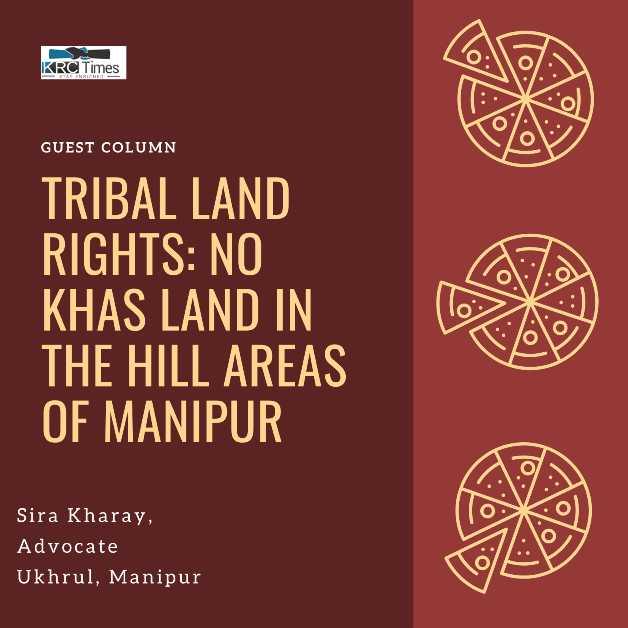“No Khas Land” does not mean any sort of magic wand for alarm as deliberately misconstrued, as it in law simply means that the tribals are not aliens/migrants/immigrants in their own homeland but are the original settlers of the land and hence, their ancestral land and forest ought to be recognised as naturally their own
 KRC TIMES Manipur Bureau
KRC TIMES Manipur Bureau

By Sira Kharay, Advocate
INTRODUCTION
In the dehumanising colonial doctrine of “terra nullius”, the ruling dispensation seems to have found a new sadistic pleasure for aggressive “territorial imagination” by asserting that the “Hill Areas” of Manipur are a “No man’s land”.
“Land”, however, is sacred to the tribals. In the traditional belief system of their forefathers, “Land is older than man” and “it is a forbidden thing for the Nagas not to defend their ancestral land and forest from the intrusion of the enemies (emphasis added)”.
“Land”, opines the Hon’ble Supreme Court of India in Samatha vs. State of Andhra Pradesh & Ors., “is their most important natural and valuable asset and imperishable endowment from which the tribals derive their sustenance, social status, economic and social equality, permanent place of abode and work and living. It is a security and source for economic empowerment. Therefore, the tribes too have a great emotional attachment to their lands. The land on which they live and till, assures them equality of status and dignity of person and means to economic and social justice and potent weapon of economic empowerment in social democracy (emphasis added)”.
BRITISH TRIBAL LAND POLICY
According to natural law theorist Hugo Grotius,“Indigenous peoples constitute polities with the distinct entity under international law” (emphasis added) and the British colonial administrators did not lack behind in treating the indigenous hill tribals as separate polities in themselves as distinct from the British Indian Empire. For the British colonial administrators, land and tribal identity cannot be separated.
Accordingly, the Assam Land & Revenue Regulation, 1886 was promulgated and a special chapter was inserted classifying these indigenous tribal belts/blocks as Backward Classes for special protection. The same was subsequently amended by the Assam Land & Revenue Regulation (Amendment) Act, 1964, and this amendment Act was extended to the State of Manipur by a notification issued under Section 2 of the Union Territories (Laws) Act, 1950.
As per the provisions of Section 164(2) of the said Regulation, no land-holder in this tribal belt is permissible to transfer his land to any non-tribal or to any person who is not a permanent resident thereof. Section 164(A) thereto further provides that no person to whom any land is transferred in such tribal belts/blocks in contravention of the provisions of Chapter-X, shall acquire any right or title in that land by the length of possession whether adverse or not.
The hill tribals’ authority over land was thus recognised as organic and not granted by the state. The British accordingly treated the hill tribals as sovereign entities and consistently negotiated with them through separate treaties all throughout its history. This is also the same policy precedent followed by the British as in the case of the native American Indian tribes (Worcestor vs. Georgia).
CONTEMPORARY INTERNATIONAL PRACTICE
In the American legal philosophy, the Indian tribes constitute a “separate entity”, recognizing the right to govern themselves as inherent in the tribes and not conferred by the state. Article 1 of the Constitution of the United States accordingly confers full recognition of the concept of tribal sovereignty and the right to self-determination of the Indian tribes (Montana vs. United States). In Washington vs. Confederated Tribes of Colville Indian Reservation, it was further affirmed that tribal sovereignty is subordinate only to the federal government and not to the states. Thus, tribal law prevails wherever there is no federal legislation in America as contrary to the Indian practice.
In the same manner, the Australian High Court in a historic ruling came to reject the dehumanising doctrine of “terra nullius” in Mabo vs. Queensland, thereby eventually recognising the land rights of the indigenous people. Likewise, as per the ruling in Calder vs. Attorney General For British Columbia, the Canadian Supreme Court now fully recognises the land rights of the indigenous people.
In the international context, inter alia, the indigenous peoples’ rights to self-determination and their right against forcible displacement and relocation from their lands without free, prior and informed consent are now being fully recognized by the United Nations Declaration on the Rights of Indigenous People (UNDRIP), 2007.
TRIBAL STATUS IN INDIA
Ironically, India inherited academia typically hostile to any notion of self-determination. The Constitution of India for this obvious reason deliberately avoids the term “indigenous people” and its tribal populace are still being fictionally referred to as “Scheduled Tribes” as defined under Articles 366 and 342 of the Constitution. Constitutionally, the Indian tribals are thus mere “Scheduled Class” and not “indigenous”.
This is politically purposive. For the term “indigenous” connotes certain rights and obligations under international law, the term “tribe” on the other only justifies the denial of the same. In the Indian practice, thus, “status” is assumed as “conferred” rather than being “recognised” as, unlike her European counterparts.
Accordingly, the constitutional jargons such as “Special Provisions” such as in Article 371C, “Sixth Schedule”, “Fifth Schedule” and “Scheduled Areas” are at best conceptual misnomers to further mystify this status of right as being “conferred” and the distorted notion of “social justice” in the regime of “reservation” only perpetuates this systemic injustice rather than being really empowered.
That is not to altogether downplay the entire welfarist objects of these special provisions. However, the real tangible effort in righting the historical injustice done to the tribals only begins when the Panchayats (Extension to Scheduled Areas) Act, 1996 was enacted which for the first time recognises tribal right over “community resources” and ownership right over “minor forest produces”. Thereafter, the Scheduled Tribes and Other Traditional Forest Dwellers (Recognition of Forest Rights) Act, 2006 was enacted which lately recognises and vests the forest rights, common or individual, including customary common forest land within the traditional or customary boundaries of the village in the forest-dwelling Scheduled Tribes and other traditional forest dwellers.
HILL TRIBALS: MANIPUR CONTEXT
Article 371C of the Constitution of India provides a special provision for the separate administration of the hill tribal areas of Manipur through the constitution of the Hill Areas Committee (HAC). As per the Explanation thereto, the only competent authority to define the term “Hill Areas” is the President of India alone and the state has no legislative competence to either abridge or alter the meaning of the same. Article 371C of the Constitution is a “special” provision and the same cannot be abrogated as it is not a “temporary” provision unlike Article 370.
In pursuance of the special power conferred by Article 371C, V.V. Giri, the then President of India, came to promulgate the Manipur Legislative Assembly (Hill Areas Committee) Order, 1972. As per the Second Schedule to that Order, the scheduled matters thereto including “allotment, occupation, or use, or the setting apart of land for the purposes of agriculture or grazing or for residential or other non-agricultural purposes or for any other purpose” in the “Hill Areas” were brought under the exclusive purview of the Hill Areas Committee (HAC) and the administrative/executive function thereto being conferred upon the Autonomous District Councils (ADCs) under the Manipur (Hill Areas) District Councils Act, 1971.
Additionally, apart from the existing protection conferred under the Assam Land & Revenue Regulation, 1886 and the Assam Land & Revenue Regulation (Amendment) Act, 1964 which are still in full force, the land right of the hill tribals is further protected by the provisions of Section 158 of the Manipur Land Revenue & Land Reforms Act, 1960 which prohibits any transfer of tribal land to non-tribals.
NO KHAS LAND: HILL DISTRICTS STILL REMAIN UN-SURVEYED
The term “Khas Land” may be roughly understood as state-owned wasteland, where nobody has ownership right and “which is available for allocation according to government priorities.”
As a matter of fact, the hill districts of Manipur as unto date remain un-surveyed districts. In Hunphun Katamnao Long vs. State of Manipur, the Hon’ble High Court of Manipur observes that Ukhrul District is still within the category of the un-surveyed district and no records of rights are accordingly maintained by the District Administration as on date. In the said proceedings, the Deputy Commissioner, Ukhrul made a candid admission that the Survey Records 1979-90 was not published in the Gazette and the same was withdrawn due to litigation.
Concurring with the ratio of the Judicial Commissioner in Luitang Khullakpa and Ors. vs. Deputy Commissioner of Manipur and Ors., the Hon’ble Gauhati High Court in Hundung Victims of Development vs. North Eastern Council concludes that there is no government Khas land in the Hill Areas of Manipur; the ownership of land situated in the hill villages of Manipur vests in the villagers themselves; and hence, the tribals within the state do not hold their land under the pleasure of the State Government.
The Hon’ble High Court of Manipur itself has also consistently followed the above-settled principle of law. As in the most recent decided matters of N. Lokho vs. State of Manipur and C. Wungam vs. Union of India, Justice S. Serto was pleased to reaffirm that “From the judgment given above, it is clear that ownership of land in the hills lies with the people i.e the villagers. This decision of the Judicial Commissioner has been consistently followed by this Court.”
This is absolutely in consonance with not only the right regime as contemplated under the Scheduled Tribes and Other Traditional Forest Dwellers (Recognition of Forest Rights) Act, 2006, but also with the contemporary customary international law and practice of the high contracting parties. Thus, no land Patta record system is also in existence in the Hill Areas of Manipur as of date.
CONCLUSION
In conclusion, the term “No Khas Land” does not mean any sort of magic wand for alarm as deliberately misconstrued, as it in law simply means that the tribals are not aliens/migrants/immigrants in their own homeland but are the original settlers of the land and hence, their ancestral land and forest ought to be recognised as naturally their own.
For these reasons obvious, the land being an aspiration, land being part and parcel of their identity, any attempt to disturb this established notion is essentially perceived by the hill tribals as a communally driven majoritarian agenda to encroach upon their traditional spaces, and thus, any such reckless intrusion only furthers the historical mistrust among the ethnic communities within the state.
(The author is a practicing advocate now based at Ukhrul, Manipur)
Advertisements | KRC Foundation







